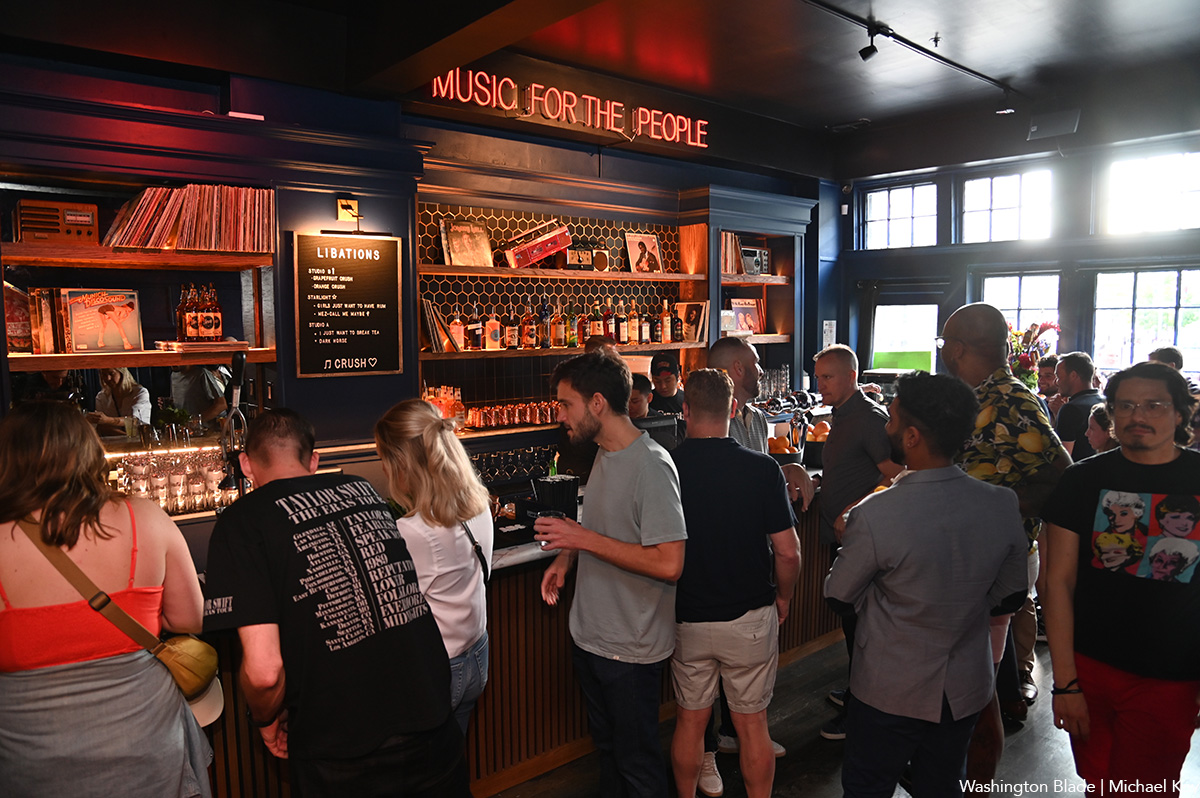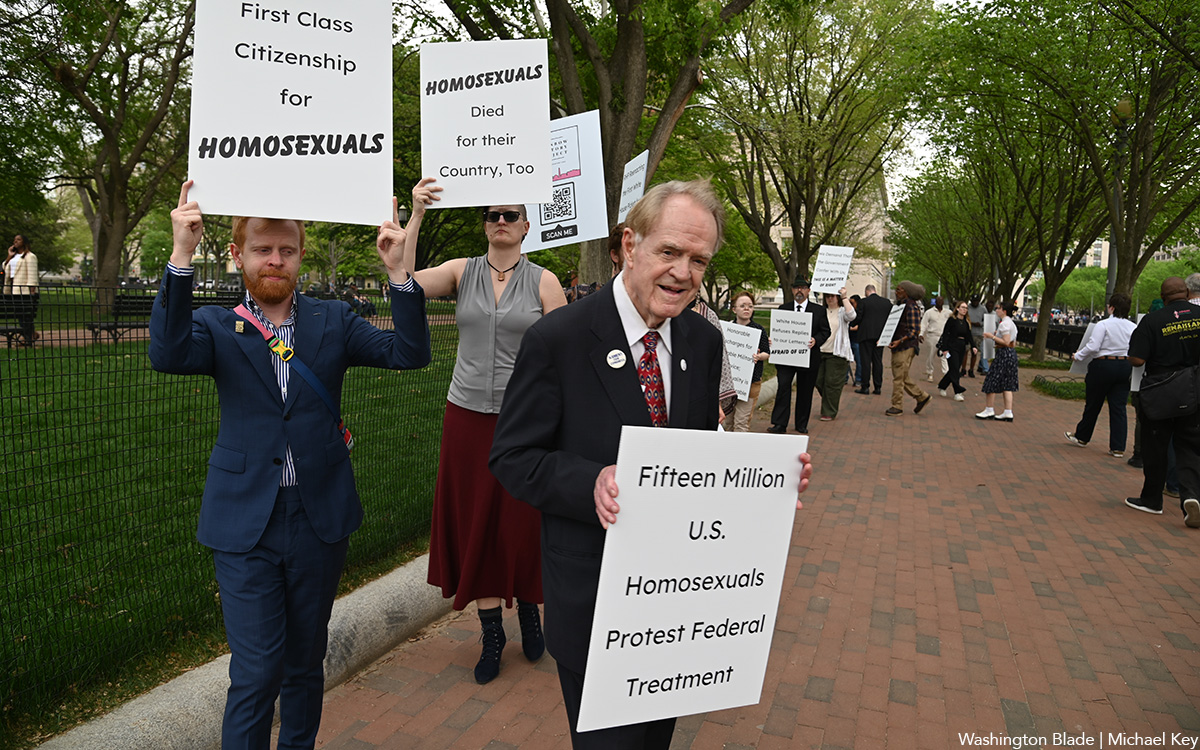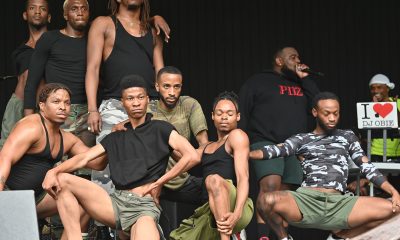Local
D.C. same-sex couples up 40% in 2010 Census
Data show Va., Md. same-sex couples up 50%
D.C. has retained its status of having the highest number of same-sex couples per 1,000 households compared to all 50 states, and it had a 40 percent increase in the number of people identifying themselves as same-sex couples since 2000.
Those are among the findings of newly released data from the 2010 U.S. Census as analyzed by the Williams Institute, a think tank affiliated with the University of Southern California at Los Angeles. The institute specializes in LGBT related issues.
The data show that Maryland had a 51 percent increase in the reported number of same-sex couples from 2000 to 2010 and Virginia saw a 49 percent increase in same-sex couples for that same ten-year period.
“The increases are far higher than population increases,” said Williams Institute official Gary Gates. “So we feel most of the increases we’re seeing in states, cities, and counties are attributable to more people reporting they’re a couple than ten years ago.”
The 2010 Census data show that 5,146 D.C. households declared themselves as being headed by same-sex couples, representing a rate of 19 same-sex couples per 1,000 households. In the 2,000 census, 3,678 households in the District identified themselves as same-sex couple households.
Of the 5,146 D.C. same-sex households reported in the 2010 Census, 72 percent were gay male couples and 28 percent lesbian couples.
Ninety percent of the same-sex households reported in the 2010 Census for D.C. were not raising children compared to just 10 percent who reported they were raising children, according to the Williams Institute analysis of the data.
The Williams Institute analysis also shows that the highest concentration of same-sex couples in D.C. reported in the 2010 Census were in census tracks in neighborhoods of Logan Circle, Dupont Circle, Shaw West, Shaw East, and an area bounded by “Morrow Drive to Piney Branch Parkway, N.W., Rock Creek and 16th Street, N.W.”
The data show that the highest concentration of same-sex couples raising children were female couples living in mostly black neighborhoods in the far Southeast and far Northeast sections of the city.
The D.C. data were released Thursday by the Williams Institute, which is known officially as the Williams Institute on Sexual Orientation and Gender Identity Law and Public Policy. The Williams Institute has analyzed Census data pertaining to same-sex couples since the 2000 U.S. Census, when the census first began counting them.
The 2010 Census data released by the Williams Institute show these figures for same-sex couples living in D.C. area suburban jurisdictions:
- Montgomery County, Md. – 2,911 same-sex couples; 8.2 same-sex couples per 1,000 households
- Prince George’s County, Md. – 2,525 same-sex couples; 8.3 same-sex couples per 1,000 households
- Fairfax County, Va. – 2,783 same-sex couples; 7.1 same-sex couples per 1,000 households
- Arlington, Va. – 1,328 same-sex couples; 13.5 same-sex couples per 1,000 households
- Alexandria, Va. – 941 same-sex couples; 13.8 same-sex couples per 1,000 households
- Baltimore, Md. – 3,226 same-sex couples; 12.9 same-sex couples per 1,000 households
Gates said the data the institute has analyzed so far show that the number of same-sex couples reported nationwide has increased by about 50 percent between 2000 and 2010. Gates said population growth and migration of LGBT people to certain locations accounts for some of the increase.
But he said most of the increase appears to be due to a decision by far more same-sex couples to self-identify while filling out the 2010 U.S. Census questionnaire, which was sent to all U.S. households.
Although D.C.’s rate of 19 same-sex couples per 1,000 households is the highest among the 50 states, several cities have rates far higher than D.C. if D.C. were to be viewed as a city.
Provincetown, Mass., a gay vacation destination with a sizable population of LGBT people living there year-round, leads the nation among cities with 50 or more same-sex couple households, with a rate of 163 same-sex couples per 1,000 households, Gates said.
The city of Wilton Manor, Fla., long known as an LGBT-friendly enclave next to Fort Lauderdale, came in second among cities in the 50 or more same-sex household category, with a rate of 140 same-sex couples per 1,000 households, according to Gates.
Palm Spring, Calif., came in third, with 115 same-sex couples per 1,000 households, Gates said.
In a development that appears to represent an LGBT population shift more than a greater degree of gay couples “coming out” in the Census questionnaire, Gates said the city of Rehoboth Beach, Del., came in fourth place in the category of same-sex couples in cities with 50 or more same-sex households.
Gates said the 2010 Census data show Rehoboth, a popular LGBT resort town, has a rate of 107 same-sex couples per 1,000 households. Gates noted that the actual number of same-sex couple households counted in the 2010 Census for Rehoboth was 81, an increase of 47 couples over the 34 same-sex couples that declared themselves in the 2000 Census.
“I think what you see there is this kind of movement from vacation home to actual residence for a lot of people,” Gates said. “I think in the last decade people made a lot on the real estate market in D.C. and bought vacation properties in Rehoboth. And I think now quite a few of them have moved there.”
Steve Elkins, an official with Camp Rehoboth, an LGBT advocacy group and community center in Rehoboth, said the census figures don’t surprise him.
“You see it every day. We’re in all walks of life,” he said, from local politics to the outlet malls.
Maryland
Rockville teen charged with plotting school shooting after FBI finds ‘manifesto’
Alex Ye charged with threats of mass violence

BY BRETT BARROUQUERE | A Montgomery County high school student is charged with what police describe as plans to commit a school shooting.
Andrea Ye, 18, of Rockville, whose preferred name is Alex Ye, is charged with threats of mass violence. Montgomery County Police and the FBI arrested Ye Wednesday.
The rest of this article can be found on the Baltimore Banner’s website.
District of Columbia
New D.C. LGBTQ+ bar Crush set to open April 19
An ‘all-inclusive entertainment haven,’ with dance floor, roof deck

D.C.’s newest LGBTQ+ bar called Crush is scheduled to open for business at 4 p.m. on Friday, April 19, in a spacious, two-story building with a dance floor and roof deck at 2007 14th St., N.W. in one of the city’s bustling nightlife areas.
A statement released by co-owners Stephen Rutgers and Mark Rutstein earlier this year says the new bar will provide an atmosphere that blends “nostalgia with contemporary nightlife” in a building that was home to a popular music store and radio supply shop.
Rutgers said the opening comes one day after Crush received final approval of its liquor license that was transferred from the Owl Room, a bar that operated in the same building before closing Dec. 31 of last year. The official opening also comes three days after Crush hosted a pre-opening reception for family, friends, and community members on Tuesday, April 16.
Among those attending, Rutgers said, were officials with several prominent local LGBTQ organizations, including officials with the DC Center for the LGBTQ Community, which is located across the street from Crush in the city’s Reeves Center municipal building. Also attending were Japer Bowles, director of the Mayor’s Office of LGBTQ Affairs, and Salah Czapary, director of the Mayor’s Office of Nightlife and Culture.
Rutgers said Crush plans to hold a grand opening event in a few weeks after he, Rutstein and the bar’s employees become settled into their newly opened operations.
“Step into a venue where inclusivity isn’t just a promise but a vibrant reality,” a statement posted on the Crush website says. “Imagine an all-inclusive entertainment haven where diversity isn’t just celebrated, it’s embraced as the very heartbeat of our venue,” the statement says. “Welcome to a place where love knows no bounds, and the only color or preference that matters is the vibrant tapestry of humanity itself. Welcome to Crush.”
The website says Crush will be open Tuesdays and Wednesdays from 4 p.m. to 12 a.m., Thursdays from 4 p.m. to 2 a.m., Fridays from 4 p.m. to 3 a.m., Saturdays from 2 p.m. to 3 a.m., and Sundays from 2 p.m. to 12 a.m. It will be closed on Mondays.
Crush is located less than two blocks from the U Street Metro station.
District of Columbia
Reenactment of first gay rights picket at White House draws interest of tourists
LGBTQ activists carry signs from historic 1965 protest

About 30 LGBTQ activists formed a circular picket line in front of the White House Wednesday afternoon, April 17, carrying signs calling for an end to discrimination against “homosexuals” in a reenactment of the first gay rights protest at the White House that took place 59 years earlier on April 17, 1965.
Crowds of tourists looked on with interest as the activists walked back and forth in silence in front of the White House fence on Pennsylvania Avenue. Like the 1965 event, several of the men were dressed in suits and ties and the women in dresses in keeping with a 1960s era dress code policy for protests of the Mattachine Society of Washington, D.C., the city’s first gay rights group that organized the 1965 event.
Wednesday’s reenactment was organized by D.C.’s Rainbow History Project, which made it clear that the event was not intended as a protest against President Joe Biden and his administration, which the group praised as a strong supporter of LGBTQ rights.
“I think this was an amazing event,” said Vincent Slatt, the Rainbow History Project official who led efforts to put on the event. “We had twice as many that we had hoped for that came today,” he said.
“It was so great to see a reenactment and so great to see how far we’ve come,” Slatt said. “And also, the acknowledgement of what else we still need to do.”
Slatt said participants in the event who were not carrying picket signs handed out literature explaining the purpose of the event.
A flier handed out by participants noted that among the demands of the protesters at the 1965 event were to end the ban on homosexuals from working in the federal government, an end to the ban on gays serving in the military, an end to the denial of security clearances for gays, and an end of the government’s refusal to meet with the LGBTQ community.
“The other thing that I think is really, really moving is some of the gay staff inside the White House found out this was happening and came out to greet us,” Slatt said. He noted that this highlighted how much has changed since 1965, when then President Lyndon Johnson’s White House refused to respond to a letter sent to Johnson from the Mattachine Society explaining its grievances.
“So now to have gay people in the White House coming out to give us their respects and to say hello was especially meaningful to us,” Slatt said. “That was not expected today.”
Among those walking the picket line was longtime D.C. LGBTQ rights advocate Paul Kuntzler, who is the only known surviving person who was among the White House picketers at the April 1965 event. Kuntzler said he proudly carried a newly printed version of the sign at Wednesday’s reenactment event that he carried during the 1965 protest. It stated, “Fifteen Million Homosexuals Protest Federal Treatment.”
Also participating in the event was Japer Bowles, director of D.C. Mayor Muriel Bowser’s Office of LGBTQ Affairs. Bowles presented Slatt with a proclamation issued by Bowser declaring April 17, 2024, Mattachine Society Day in Washington, D.C.
“Whereas, on April 17, 1965, the Mattachine Society of Washington courageously held the nation’s inaugural picket for gay rights, a seminal moment in the ongoing struggle for LGBTQIA+ equality in the United States, marking the genesis of public demonstrations advocating for those rights and paving the way for Pride Marches and Pride celebrations worldwide,” the proclamation states.
About 30 minutes after the reenactment event began, uniformed Secret Service agents informed Slatt that due to a security issue the picketers would have to move off the sidewalk in front of the White House and resume the picketing across the street on the sidewalk in front of Lafayette Park. When asked by the Washington Blade what the security issue was about, one of the Secret Service officers said he did not have any further details other than that his superiors informed him that the White House sidewalk would have to be temporarily cleared of all people.
Participants in the event quickly resumed their picket line on the sidewalk in front of Lafayette Park for another 30 minutes or so in keeping with the 1965 picketing event, which lasted for one hour, from 4:20 p.m. to 5:20 p.m., according to Rainbow History Project’s research into the 1965 event.
Although the LGBTQ picketers continued their procession in silence, a separate protest in Lafayette Park a short distance from the LGBTQ picketers included speakers shouting through amplified speakers. The protest was against the government of Saudi Arabia and organized by a Muslim group called Al Baqee Organization.
A statement released by the Rainbow History Project says the reenactment event, among other things, was a tribute to D.C.-area lesbian rights advocate Lilli Vincenz, who participated in the 1965 White House picketing, and D.C. gay rights pioneer Frank Kameny, who founded the Mattachine Society of Washington in the early 1960s and was the lead organizer of the 1965 White House protest. Kameny died in 2011 and Vincenz died in 2023.
The picket signs carried by participants in the reenactment event, which were reproduced from the 1965 event, had these messages:
• “DISCRIMINATION Against Homosexuals is as immoral as Discrimination Against Negroes and Jews;”
• “Government Should Combat Prejudice NOT PROMOTE IT”
• “White House Refuses Replies to Our Letters, AFRAID OF US?
• “HOMOSEXUALS Died for their Country, Too”
• “First Class Citizenship for HOMOSEXUALS”
• “Sexual Preference is Irrelevant to Employment”
• “Fifteen Million U.S. Homosexuals Protest Federal Treatment”
-

 Africa4 days ago
Africa4 days agoCongolese lawmaker introduces anti-homosexuality bill
-

 District of Columbia24 hours ago
District of Columbia24 hours agoReenactment of first gay rights picket at White House draws interest of tourists
-

 World4 days ago
World4 days agoOut in the World: LGBTQ news from Europe and Asia
-

 Arizona1 day ago
Arizona1 day agoAriz. governor vetoes anti-transgender, Ten Commandments bill











